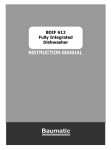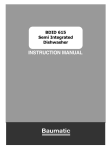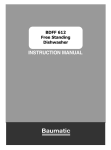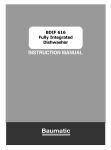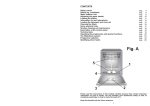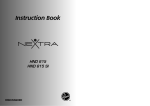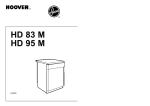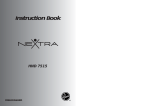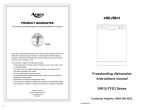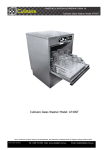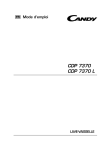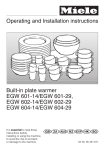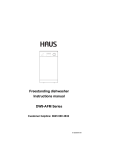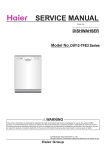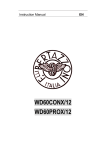Download User manual
Transcript
BDIF 615
Fully Integrated
Dishwasher
INSTRUCTION MANUAL
CONTENTS
General safety rules
Water connection
Loading the salt
Adjusting the upper basket
Loading the dishes
Information for test laboratories
Loading the detergent
Types of detergent
Loading the rinse aid
Cleaning the filters
Some practical hints
Routine cleaning and maintenance
Description of the control panel
Technical data
Programme selection and special functions
Water softner unit
Programme guide
Identifying minor faults
Product fiche
WEEE information
Contact details
pag.
pag.
pag.
pag.
pag.
pag.
pag.
pag.
pag.
pag.
pag.
pag.
pag.
pag.
pag.
pag.
pag.
pag.
pag.
pag.
pag.
3
6
8
9
10
12
13
14
15
16
17
18
19
19
20
23
24
26
28
29
31
Fig. A
5
1
4
2
3
Please read the instructions in this booklet carefully because they contain important
information on how to install, use and maintain your dishwasher safely as well as
containing useful tips on how to make the most of it.
Keep this booklet safe for future reference.
2
above and persons with reduced
physical, sensory or mental
capabilities or lack of experience
and knowledge if they have been
given supervision or instruction
concerning use of the appliance in
a safe way and understand the
hazards involved.
Children shall not play with the
appliance. Cleaning and user
maintenance shall not be made
by children without supervision.
GENERAL SAFETY RULES
■ This appliances is intended to be
used in household and similar
applications such as:
- staff kitchen areas in shops,
offices and other working
environments;
- farm houses;
- by clients in hotels, motels
and other residential type
environments;
- bed and breakfast
environments.
■ Children should be supervised to
ensure that they do not play with
the appliance.
type
■ Children of less than 3 years
should be kept away unless
continuously supervised.
A different use of this appliance
from household environment or
from
typical
housekeeping
functions, as commercial use by
expert or trained users, is
excluded even in the above
applications.
■ Should it be necessary to replace
the supply cord, call the Customer
Care Department.
■ The appliance must be connected
to the water mains using new
hose-sets. The old hose-sets
should not be reused.
If the appliance is used in a
manner inconsistent with this
it may reduce the life of the
appliance and may void the
manufacturer’s warranty.
■ Water pressure must be between
0,08 MPa and 0,8 MPa.
Any damage to the appliance or
other damage or loss arising
through use that is not consistent
with domestic or household use
(even if located in a domestic or
household environment) shall not
be accepted by the manufacturer
to the fullest extent permitted by
law.
■ This appliance can be used by
children aged from 8 years and
■ When the appliance is located on
a carpet floor, attention must be
paid to ensure that there is no
obstruction to the bottom vents.
3
■ After installation, the appliance
must be positioned so that the
plug is accessible.
■ In general it is not advisable to use
adaptors, multiple plugs and/or
extension cables.
■ For the maximum place loading,
please refer to the "TECHNICAL
DATA" table/section.
■ Do not remove the plug from the
mains supply socket by pulling the
mains cable or the machine itself.
WARNING !
Knives and other utensils with
sharp points must be loaded
in the basket with their points
down or placed in a horizontal
position.
■ Do not leave the appliance exposed to the elements (rain, sun etc).
■ Leaning or sitting on the open
door of the dishwasher could
cause it to tip over.
■ The door should not be left in the
open position since this could
present a potential hazard ( e.g.
tripping ).
■ The dishwasher is designed for
normal kitchen utensils.
Objects that have been contamined by petrol, paint, traces of steel
or iron, corrosive chemicals, acids
or alkalis must not be washed in
the dishwasher.
■ To consult the product fiche
please refer to the relevant page
in this user manual.
■ If there is a water softening device
installed in the home there is no
need to add salt to the water softener fitted in the dishwasher.
Safety instructions
■ Make sure the electrical system
is grounded. Otherwise, seek
qualified professional assistance.
■ If the appliance breaks down or
stops working properly, switch it
off, turn off the water supply and
do not tamper with it. Repair work
should only be carried out by an
approved service agent and only
genuine spare parts should be fitted. Any failure to follow the above
advice may have serious consequences for the safety of the
appliance.
Manufacturer declines all
responsibility for any damage
due to non-earthing of the
machine.
■ Ensure that the dishwasher does
not crush power cables.
4
■ If it you need to move the machine after removing the packaging,
do not try to lift it by the bottom of
the door.
Open the door slightly and lift the
machine by holding on the top.
Appliance complies
European Directives:
with
■ 2006/95/EC (LVD);
■ 2004/108/EC (EMC);
■ 2009/125/EC (ErP);
■ 2011/65/EU (RoHS)
and subsequent amendments
■ For the installation of built-in
appliances, please refer to the
specific chapter or to the instructions enclosed with the booklet.
5
WATER CONNECTION
IMPORTANT
The appliance must be connected to
the water mains using new hose-sets.
The old hose-sets should not be reused.
1
■ The inlet and drain hoses can be directed
to left or right.
IMPORTANT
The dishwasher can be connected to
either cold or hot water, as long as it
is no hotter than 60°C.
■ Water pressure must be between
0,08 MPa and 0,8 MPa.
2
■ The inlet hose must be connected to a
tap so that the water supply can be cut
off when the machine is not in use
(fig. 1 B).
■ The dishwasher is fitted with 3/4" threaded
connector (fig. 2).
■ Connect inlet hose “A” to water tap “B”
with a 3/4" attachment making sure that
it has been properly tightened.
■ If it is necessary, the inlet pipe can be
lengthened up to 2,5 m. The extension
pipe is available from the Spares
Department.
■ If the dishwasher is connected to new
pipes or to pipes which have not been in
use for a long time run water through for
a few minutes before connecting the
inlet hose. In this way no deposits of
sand or rust will clog up the water inflow
filter.
6
■ The hose can be hooked over the side of
the sink, but it must not be immersed in
water, in order to prevent water from
being syphoned back to the machine
when this is in operation (fig. 4Y).
Connecting the outlet hose
■ The outlet hose should disharge into a
standpipe, making sure that there are no
kinks (fig. 4).
■ When installing the appliance under a
worktop the hose pipe clamp must be
attached to the wall in the highest possible
position under the worktop (fig. 4Z).
■ The standpipe must be at least 40 cm
above floor level and it must have an
internal diameter of at least 4 cm.
■ Check that there are no kinks in the inlet
and outlet hoses.
■ It is advisable to fit an anti-odour air trap
(fig. 4X).
■ If necessary the outlet hose can be
extended up to 2,5 m, provided that it is
kept at a maximum height of 85 cm
above floor level. The extension pipe is
available from the Spares Department.
4
7
■ The salt dispenser has a capacity of
between 1.5 and 1.8 kg and, for efficient
use of the appliance, it should be refilled
from time to time according to the
regulation of the water softener unit.
LOADING THE SALT
■ The appearance of white stains on dishes
is generally a warning sign that the salt
container needs filling.
■ On the bottom of the machine there is a
container for the salt for regenerating
the softener.
IMPORTANT
(Only for first start up)
When the appliance is used for the
first time, after completely filling the
salt container, it is necessary to add
water until the container overflows.
■ It is important to use only a salt that is
specifically designed for dishwasher.
Other types of salt contain small quantities
of insoluble particles which over a long
period of time may affect and deteriorate
the softener performance.
■ To add salt, unscrew the cap of the container on the bottom and then refill the
container.
■ During this operation a little water will
overflow; but keep adding salt until the
container is full. When the container is
full, clean the thread of salt residue and
retighten the tap.
■ After filling with salt, it is recommended to
run a complete wash cycle, or COLD
RINSE programme to clear any residual
salt from the inside of the cabinet.
IMPORTANT
After loading the salt, YOU
MUST run a complete washing
cycle, or the PRE-WASH/COLD
RINSE/REFRESH programme.
8
ADJUSTMENT OF THE
UPPER BASKET
1
If 29 cm to 32.5 cm plates are normally
used, load them onto the lower basket after
the upper basket has been placed in its
upper position and proceed as detailed
below:
1. Pull out the upper basket;
2
2. Then grasp the basket from both sides
and lift it upwards (fig. 1).
a
b
a
Dishes that are bigger than 20 cm in
diameter can no longer be loaded onto the
upper basket and the mobile supports
cannot be used when the basket is in the
upper position.
b
ADJUST BASKET TO THE LOWER
POSITION:
3
1. Grasp the basket from both sides and lift
slightly upwards (fig. 2a);
2. Then slowly release into the correct
position (fig. 2b).
N. B. : NEVER LIFT OR LOWER THE
BASKET BY ONE SIDE ONLY (fig.3).
Attention :
it is advisable to adjust the basket before
loading the dishes.
9
A standard daily load is represented in
figs. 1, 2 and 3.
LOADING DISHES
Using the upper basket
Upper basket (fig. 1)
A = soup plates
B = dinner plates
C = dessert plates
D = saucers
E = cups
F = glasses
■ The upper basket is provided with
mobile racks hooked to the sides of the
basket, which can be regulated into 4
positions.
■ In the lowered position (A-A1) the racks
may be used for such items as: tea and
coffee cups, kitchen knives and ladles.
Also glasses with stems may be safely
hung on the ends of the racks.
A
1
A1
B
D
■ In the upright position (B-B1) the racks
allow you to load dinner plates and soup
plates. Plates should be loaded
vertically with the underside of the plate
towards the back of the dishwasher with
a space between each plate to allow
water to pass freely.
B
F
Upper basket (fig. 2)
A = soup plates
B = dinner plates
C = dessert plates
D = saucers
E = cups
F = glasses with stems
G = glass
H = cutlery basket
B1
■ It is advisable to load large plates
(approx. 26 or more cm) slightly tilted
towards the rear to facilitate introduction
of the basket into the machine.
2
B
A
■ Salad bowls and plastic bowls may also
be loaded on the upper basket. It is
advisable to block these in place so that
the jets of water do not make them
overturn.
■ The upper basket has been designed to
offer maximum flexibility in use and can
be loaded with up to 24 plates on two
rows, up to 30 glasses on five rows or a
mixed load.
E
C
A
H
10
C
D F
E
F
G
- POSITION “B”: for dishes which,
although standard size, have a particular
shape (very deep bowls, square dishes
or ones without borders etc.).
Upper basket (fig. 3)
A = glasses
B = saucers
C = cups
D = small bowl
E = medium bowl
F = large bowl
G = dessert plate
H = serving spoons
I = ladle
L = cutlery
3
- POSITION “C”: for larger than average
flat plates and/or ones with nonstandard shapes (square, hexagonal,
oval, pizza dishes etc.).
4
I
L
F
C
B
A
G
C D
E
C
5
B
C
A
H
A
H
■ The small plates, as those used for
desserts for example, must be placed in
the lower basket as shown in the figure 6,
with the support flap placed outwards ("B").
For normal or large plates the flap must
be in the position ("A").
Using the lower basket
■ Saucepans, oven dishes, tureens, salad
bowls, lids, serving dishes, dinner
plates, soup plates and ladles can be
loaded on the lower basket.
6
■ Place the cutlery in the plastic cutlery
holder with the handles pointing
upwards.
■ Place the cutlery holder in the lower
basket (fig. 7 and 8), making sure that
the cutlery does not get in the way of the
rotating arms.
A
■ The lower basket is fitted with a special
adjustable central rack (fig. 4 and 5).
This permits stable and optimum
loading, even when the size and/or
shape of the dishes is non-standard.
B
WARNING!
If the small plates are placed in the
basket with the support flap in the
incorrect position, the plates will
interfere with the lower spraying arm
preventing it to rotate.
- POSITION “A”: for a standard load, or
one that excludes pans, salad bowls and
the like.
11
Please load the dishwasher sensibly to
obtain the best wash results.
A standard daily load is represented in
figs. 7 and 8.
Lower basket (fig. 7)
A = medium-sized saucepan
B = large saucepan
C = frying pan
D = tureens, serving dishes
E = cutlery
F = oven dishes
G = medium bowl
H = small bowl
IMPORTANT
The lower basket has a safety-stop
device, for its safe extraction, also
especially useful with a full load.
For loading salt, cleaning filter and for
ordinary maintenance, the complete
extraction of the basket is necessary.
7
B
A
F
Cutlery basket (fig. 9)
The top of cutlery basket can be removed,
for enable various loading options.
C
G
D
E
H
9
Lower basket (fig. 8)
A = soup plates
B = dinner plates
C = dessert plates
D = serving dish
E = cutlery
8
D
INFORMATION FOR THE TEST
LABORATORIES
B
A
Please ask information required for
comparison testing and measuring noise
levels, according to EN normative, to the
following address:
C
C
[email protected]
In the request, please specify model name
and number of the dishwasher (see rating
plate).
E
12
LOADING THE DETERGENT
The detergent
IMPORTANT
It is essential to use a detergent
that is specifically designed for
dishwashers either in powder, liquid
or tablet form.
B
After pouring the detergent into the container,
close the lid, firstly pushing (1) and then
pressing on it (2) until you hear the click.
“FINISH” gives very good results and can
be easily obtained.
Unsuitable detergents (like those for
washing up by hand) do not contain the
proper ingredients for use in a dishwasher,
and stop the dishwasher from working
correctly.
Filling the detergent container
The detergent container is inside the door
(fig. A “2”). If the lid of the container is
closed, press the button (A) to open.
At the end of every wash cycle the lid is
always open and ready for the next time
the dishwasher is used.
Since not all detergents are the same the
instructions on the boxes of detergent can
vary. We should just like to remind users
that too little detergent does not clean the
dishes properly whilst too much detergent
will not produce better results and is also a
waste.
WARNING!
When loading the lower basket, please
ensure that the plates or others do not
obstruct the detergent dispenser.
The amount of detergent to be used varies
according to how dirty the dishes are and
on the type of dishes to be washed.
We advise using 20:30 g of detergent in the
wash section of detergent compartment (B).
IMPORTANT
Do not use an excessive amount of
detergent and help limit damage to
the environment at the same time.
A
13
■ The effectiveness of detergents containing
the built in water softener/salt depends
on the hardness of your water supply.
Check that the hardness of your water
supply is within the effective range given
on the detergent packaging.
TYPES OF DETERGENT
Detergent tablets
Detergent tablets of different manufacturers
dissolve at different speeds, for this
reason, during short programmes, some
detergent tablets may be not fully effective,
because they are not completely dissolved.
If these products are used, is recommended
to choose longer programmes to guarantee
the complete use of the detergent.
If when using this type of product, you
don't get satisfactory washing results,
please
contact
the
detergent
manufacturer.
In certain circumstances use of combined
detergents can cause:
IMPORTANT
To get satisfactory washing results,
the tablets MUST be placed in the
wash section of the detergent
container and NOT directly in the
tub.
■ limescale deposits on dishes or in the
dishwasher;
■ a reduction in washing and drying
performance.
Concentrated detergents
IMPORTANT
Any problems which arise as a direct
result of the use of these products
are not covered by our warranty.
The concentrated detergents, with reduced
alkalinity and with natural enzymes, in
conjunction with 50°C wash programmes,
have a smaller impact on the environment
and they protect the dishes and the
dishwasher.
The 50°C wash programmes purposely
exploit the dirt-dissolving properties of the
enzymes, allowing therefore, with the use
of the concentrated detergents, to achieve
the same results of the 65°C programmes
but at a lower temperature.
Please note that using the "ALL in 1"
combined detergents, the rinse aid and
salt indicator lights (only used on
selected models) are superfluous, so you
must ignore the lights.
Combined detergents
If washing and/or drying problems occur,
we recommend you return to use traditional
separate products (salt, detergent and
rinse agent). This will ensure that the water
softener in the dishwasher operates
correctly.
The detergents that also contain the rinse
aid must be placed in the wash section of
the detergent container. The rinse aid
container must be empty (if it is not empty,
set the rinse aid regulator to lowest position
before using combined detergents).
In this case, we recommends that you:
■ refill both the salt and rinse aid container;
"ALL in 1" combined detergents
■ run one normal washing cycle without a
load.
If you are planning to use “ALL in 1” (“3 in 1 “/
“4 in 1”/ “5 in 1”, etc.) combined detergents i.e.
those with built in salt and/or rinse agent,
we would advise the following:
Please note that on return to the use of
conventional salt, a number of cycles will
be required before the system becomes
fully efficient again.
■ Read carefully and follow the manufacturer’s
instructions given on the packaging;
14
LOADING THE RINSE AID
The rinse aid
The rinse aid, which is automatically
released during the last rinsing cycle, helps
the dishes to dry quickly and prevents
spots and stains forming.
Filling the rinse aid container
C
The rinse aid container can be found to the
left of the detergent container (fig. A "3").
To open the lid, push the reference mark
and, in the same time, pull the tab of
opening.
It is always advisable to use rinse aid that
is specifically designed for dishwasher.
Check the rinse aid level through the
indicator eye (C) which is located on the
dispenser.
FULL
EMPTY
dark
light
Regulating the rinse aid from 1 to 6
The regulator (D) is placed under the lid
and can be turned using a coin.
The recommended position is 4.
The limestone content of the water
considerably affects the formation of
limescale and the drying performance.
It is therefore important to regulate the
quantity of rinse aid to achieve good
washing results.
If, after the wash, streaks occur on the
dishes, decrease the amount by one
position. If whitish spots occur, increase the
amount by one position.
D
15
CLEANING THE FILTERS
The filter system (fig.A “4”) consists of:
1
a central container that traps the larger
particles;
a flat gauze that continuously filters the
wash water;
a micro filter, located beneath the gauze,
that traps the tiniest particles ensuring a
perfect rinse.
■ To achieve excellent results every time,
the filters should be checked and
cleaned after each wash.
■ To remove the filter unit, simply turn the
handle anticlockwise (fig. 1).
2
■ For ease of cleaning, the central container
is removable (fig. 2).
■ Remove the gauze filter (fig.3) and
wash the whole unit under a jet of
water. If necessary a small brush can
be used.
■ With the Self-cleaning Micro filter,
maintenance is reduced and the filter
unit need only be checked every two
weeks. Nevertheless, after each wash it
is advisable to check that the central
container and the gauze filter are not
clogged.
WARNING!
After cleaning the filters, make sure
that they are correctly reassembled
and that the gauze filter is properly
positioned at the bottom of the
dishwasher.
3
Make sure that the filter is screwed
back, clockwise, into the gauze, as
poor seating of the filter unit could
have an adverse effect on the
efficiency of the appliance.
IMPORTANT
Never use the dishwasher without
the filters.
16
PRATICAL HINTS
How to make savings
■ If you want the dishwasher to give a
complete wash, place the dishes in the
dishwasher at the end of each meal and
if necessary turn on the COLD RINSE
cycle to soften the food remains and
remove bigger particles of food from the
new load of dishes.
When the dishwasher is full start the
complete wash cycle programme.
How to get really good wash
results
■ Before placing the dishes in the
dishwasher, remove any remaining
food (bones, shells, pieces of meat or
vegetables, coffee grounds, skin of fruit,
cigarette ash, tooth picks etc. to avoid
blocking the filters, water outlet and
washing arm nozzles.
■ If the dishes are not very dirty or if the
baskets are not very full select an
ECONOMY programme, following the
instructions in the program list.
■ Try not to rinse the dishes before
loading them into the dishwasher.
■ If saucepans and oven dishes are
encrusted with the remains of burnt or
roast food, it is advisable to leave them
to soak before washing.
What not to wash
■ It should be remembered that not all
dishes are suitable for washing in a
dishwasher.We advise against using
the dishwasher to wash items in
thermoplastic, cutlery with wooden or
plastic handles, saucepans with
wooden handles, items in aluminium,
crystal, leaded glass unless otherwise
stated.
■ Place the dishes face downwards.
■ Try to place the dishes in such a way
that they are not touching one another.
If they are loaded properly you will get
better results.
■ After loading the dishes check that the
washing arms can rotate freely.
■ Certain decorations may fade. It is
therefore a good idea before loading the
whole batch to wash just one of the
items first so as to be sure that others
like it will not fade.
■ Pans and other dishes that have
particularly stubborn food particles or
remnants of burnt food should be left to
soak in water with dishwasher
detergent.
■ It is a good idea not to put silver cutlery
with non-stainless steel handles into
the dishwasher as there could be a
chemical reaction between them.
■ To wash silver properly:
a) rinse the silver immediately after
use, especially if it has been used for
mayonnaise, eggs, fish etc.;
IMPORTANT
When buying new crockery or
cutlery always make sure that they are
suitable for washing in a dishwasher.
b) do not sprinkle detergent onto it;
c) keep it separate from other metals.
Useful hints
■ In order to avoid any dripping from the
top rack, remove the lower rack first.
■ If the dishes are to be left in the
machine for some time, leave the door
ajar, to let some air circulate and to
improve the drying performance.
17
CLEANING AND
MAINTENANCE
1
1b
■ To clean the dishwasher outside, do not
use solvents (degreasing action) neither
abrasives, but only a cloth soaked with
water.
■ The dishwasher does not require special
maintenance, because the tank is
self-cleaning.
■ Regularly wipe the door gasket with a
damp cloth to remove any food remains
or rinse aid.
2
■ Dishwasher cleaning is recommended,
in order to remove limestone deposits or
dirt. We suggest you run a washing cycle
periodically with specialist dishwasher
cleaning products. For all cleaning
operations the dishwasher must be
empty.
■ If, in spite of the routine cleaning of the
filters, you notice that the dishes or pans
are not properly washed or rinsed, check
that all the spray heads on the rotor
arms (fig. A “5”) are clear.
WHEN CYCLE IS FINISHED
If they are blocked, clean them in the
following way:
After every wash it is essential to turn off
water supply and to switch off the machine
by pressing the On/Off button to the off
position.
1. to remove the upper rotor arm, turn it
until it lines up with the stop marked
by the arrow (fig. 1b). Push it upwards
(fig. 1) and, keeping it pushed in,
unscrew it in a clockwise direction
(to reassemble it repeat the same
operation, but turn it anticlockwise).
The lower rotor arm can be removed
simply by pulling it upwards (fig. 2);
If the machine is not going to be used for
some time, it is advisable to follow these
rules:
1. do an empty wash with detergent in order
to clean the machine of any deposits;
2. wash the rotor arms under a jet of water
to clear any blockage in the spray
heads;
2. pull out the electric plug;
3. when you have finished, refit the rotor
arms in the same position, remembering
to re-align the arrow and screw into
position.
4. fill the rinse aid container;
3. turn off the water tap;
5. Ieave the door ajar;
■ Both the door lining and the tank lining
are in stainless steel; however, should
spots caused by oxidation occur, this is
probably due to a high level of iron salts
presents in the water.
■ The spots can be removed with a mild
abrasive agent; never use chlorine
based materials, steel wool, etc.
6. keep the inside of the machine clean;
7. If the machine is left in places where the
temperature is below 0°C any water left
inside the pipes may freeze. Wait until
the temperature rises above zero and
then wait for about 24 hours before
starting up the dishwasher.
18
DESCRIPTION OF THE CONTROL PANEL
E
A
B
C
D
F
G
DC
B
H
A
"ON/OFF" button
"PROGRAMME" buttons
"POWER WASH" option button
"DELAY START" button
E
"PROGRAMME STATUS" lights/
"DELAY START" time lights
F
G
H
"OPTION SELECTION" light
"PROGRAMME SELECTION" lights
"SALT EMPTY" light
DIMENSIONS
59,8 x 81,8 ÷ 89,8 x 55
117
Width x Height x Depth (cm)
Depth with door open (cm)
TECHNICAL DATA
15
9 persons
Min. 0,08 - Max. 0,8
EN 50242 place load
Capacity with pans and dishes
Water supply pressure (MPa)
See rating plate
Fuse / Power input / Supply voltage
CONSUMPTION (main programmes)*
Programme
Energy (kWh)
Water (L)
1,50
14
UNIVERSAL
2,03
20
HYGIENIC
1,04
10
ECO
0,73
9
RAPID 32'
Power consumption of the off-mode and of the left-on mode: 0,30 W / 0,80 W
*Values are measured in a laboratory according to European Standard EN 50242 (consumption may
vary according to conditions of usage).
19
PROGRAMME SELECTION
AND SPECIAL FUNCTIONS
Programme interruption
Opening the door when a programme is
running is not recommended especially
during the main wash and final hot rinse
phases. However, if the door is opened
while a programme is running (for example,
to add dishes) the machine stops
automatically. Close the door, without
pressing any buttons. The cycle will start
from where it left off.
(Use in conjunction with programme guide)
Programme settings
■ Open the door and place the dirty dishes
inside the appliance.
■ Press the "ON/OFF" button
.
All the programme indicator lights will
flash.
■ If you wish to select an option, press the
option button (the corresponding indicator
light will light up).
WARNING!
If you open the door during the
drying cycle, an audible audio signal
advises you that the drying cycle has
not yet finished.
The option button can be selected or
deselected WITHIN one minute of the
programme commencing.
Changing a running programme
■ Choose a programme by pressing the
corresponding button.
Proceed as follows to change or cancel a
running program:
■ Close the door (after an audible signal
has sounded, the programme will start
automatically).
■ Open the door.
■ Hold down the current programme button
(with the indicator light on) for at least 5
seconds. The programme indicator lights
will turn on and off individually and
sequentially and some audible signals
will sound.
WITHIN one minute of the programme
commencing, another programme
can be selected, simply by pressing
the corresponding button.
IMPORTANT
To select the "COLD RINSE" programme,
simultaneously press the "RAPID"
programme button and "POWER
WASH" option button.
■ The running programme will be cancelled and
all the programme indicator lights will flash.
■ At this point a new programme can be set.
"IMPULSE" programmes
The “IMPULSE” programmes use impluse
washing technology, which reduces
consumption, noise and increases
performance.
IMPORTANT
To cancel the "COLD RINSE"
programme, simultaneously hold
down the "RAPID" programme button
and "POWER WASH" option button.
IMPORTANT
The “intermittent” working of the
washing pump MUST NOT BE
considered a malfunction, it is a
characteristic of the impulse washing
so must be considered a normal
function of the programme.
WARNING!
Before starting a new programme,
you should check that there is still
detergent in the dispenser.
If necessary, top up the dispenser.
20
Programme operations
"DELAY START" button
When a programme is running the relevant
indicator light will remain on and the 3
“PROGRAMME STATUS” indicator lights
("WASH" , "RINSE" , and "DRY" )
will light singularly and in sequence to
indicate the current phase.
The dishwasher start time can be set with
this button, delaying the start by 3, 6 or 9
hours.
Proceed as follows to set a delayed start:
■ Press the "DELAY START" button (each
time the button is pressed the start
will be delayed by 3, 6 or 9 hours
respectively and the corresponding time
indicator light will illuminate).
If there is any break in the power supply
while the dishwasher is operating, a
special memory stores the selected
programme and, when the power is
restored, it continues where it left off.
■ To start the countdown, press the selected
programme button (the relevant indicator
light will come on, while the set time
indicator light will start to flash).
Programme end
A 5 second alarm will sound (if not muted)
3 times at 30 second intervals to signal that
the programme has ended.
The selected programme indicator light (2
indicator lights for the "COLD RINSE"
programme) will start to flash.
Dishes can now be removed and the
dishwasher turned off by pressing the
"ON/OFF" button or dishes can be loaded
for new cycle.
If a 9 hour delay is set, countdown will be
displayed by the 6h indicator light after 3
hours and the 3h indicator light after 6
hours.
At the end of the last 3 hours (at the end
of countdown) the 3h indicator light will
stop flashing and remain on to indicate the
washing phase and the programme will
start automatically.
Salt loading indicator
This model is provided with an indicator light
on the control panel which will light up
when it is necessary to reload the salt
container.
If countdown has not ended, whereby
the programme has not yet started, it is
possible to change or cancel the delayed
start and select another programme or to
select/deselect the option button, proceeding
as follows:
Option button
■ Hold down the selected programme
button for at least 5 seconds.The
programme indicator lights will turn on
and off individually and sequentially and
some audible signals will sound.
"POWER WASH" button
The "POWER WASH" option always
guarantees the best results by more
effectively dealing with heavier soiling. By
using this option, the strength of the
selected cycle will be increased, adding
one rinse and increasing the temperature
and water pressure in the washing phase
where foreseen.
This option is recommended for very dirty
dishes or when dirty dishes may not have
been pre-treated allowing the soiling to dry up.
■ The delayed start and the selected
programme will be cancelled.
All the programme indicator lights will flash.
■ Press the "DELAY START" button to
set another delayed start time (the
corresponding indicator light will turn on).
■ A new programme can be set after a
delayed time has been changed or
cancelled or an option button has selected
or deselected.
IMPORTANT
With this option selected the “IMPULSE”
wash is switched off.
21
3. Release the button when the THIRD
audible signal sounds (all the indicator
lights will flash).
Alarm mute for the PROGRAMME
END
The alarm for the programme end may be
muted as follows:
4. Press the same button again: the
flashing indicator light (memorization off)
will stop flashing and remain on
(memorization on).
IMPORTANT
The dishwasher must ALWAYS be off
before start of this procedure.
5. Turn off the dishwasher by pressing the
"ON/OFF" button to confirm the new
setting.
1. Hold down the FIRST "PROGRAMME"
button (from the right) and at the same
time switch on the dishwasher by
pressing the "ON/OFF" button (a brief
audible signal will sound).
To disable the memorization, follow the
same procedure.
2. Keep the "PROGRAMME" button pressed
for at least 15 seconds (during this time,
2 audible signals will sound).
Fault signals
3. Release the button when the second
audible signal sounds (3 "PROGRAMME
SELECTION" indicator lights will come
on).
If malfunctions or faults occur when a
programme is running the indicator light
that corresponds to the selected cycle
(2 indicator lights for the "COLD RINSE"
programme) will flash rapidly and the alarm
sounds.
In this event, turn the dishwasher off by
pressing the "ON/OFF" button.
After checking to make sure the water
inlet hose tap is open, that the drain
hose is not bent and that the siphon or
filters are not clogged, set the selected
programme again.
If the anomaly persists, contact Customer
Care Department.
4. Press the same button again: the 3
indicator lights (which indicate that the
alarm is activated) will start flashing (to
indicate that the alarm is off).
5. Turn off the dishwasher by pressing the
"ON/OFF" button to confirm the new
setting.
To turn the alarm on again, follow the same
procedure.
Memorization of the last
programme used
The last programme used can
memorized by following the below:
IMPORTANT
This dishwasher is equipped with an
anti-overflow safety device which will
automatically discharge any excess
water should a problem occur.
be
IMPORTANT
The dishwasher must ALWAYS be off
before start of this procedure.
WARNING!
To ensure the correct operation of
the anti-overflow safety device, we
recommend that the dishwasher is
not moved or tilted during operation.
If however it is necessary to tilt or
move the dishwasher, please ensure
that the washing cycle is complete
and that there is no remaining water
inside the dishwasher.
1. Hold down the FIRST "PROGRAMME"
button (from the right) and at the same
time switch on the dishwasher by
pressing the "ON/OFF" button (a brief
audible signal will sound).
2. Keep the "PROGRAMME" button pressed
for at least 30 seconds (during this time,
3 audible signals will sound).
22
WATER SOFTENER UNIT
* The water softener unit is set in the
factory at level 3, as this is suitable for
the majority of users.
Depending on the source of the supply,
water contains varying amounts of limestone
and minerals which are deposited on the
dishes leaving whitish stains and marks.
The higher the level of these minerals
present in the water, the harder the water is.
The dishwasher is fitted with a water
softener unit which, through the use of
special regenerating salt, supplies
softened water for washing the dishes.
The degree of hardness of your water can
be obtained from your water supply
company.
According to the degree of hardness of
your water, regulate the softener unit in the
following way:
IMPORTANT
The dishwasher must ALWAYS be
off before start of this procedure.
1. Hold down the FIRST "PROGRAMME"
button (from the right) and at the same
time switch on the dishwasher by
pressing the "ON/OFF" button (a brief
audible signal will sound).
Regulating the water softener
The softener unit can treat water with a
hardness of up to 90°fH (French grading)
or 50°dH (German grading) through 6
different settings.
2. Keep the "PROGRAMME" button
pressed for at least 5 seconds, UNTIL
an audible signal sounds. Some
"PROGRAMME SELECTION" indicator
lights will come on to indicate the
current water softener setting level.
The table below lists different degrees of
water hardness with the corresponding
setting for the softener unit.
ºdH
(German
grading)
Use of
regenerating
salt
Water
softener
setting
0
0-5
0-3
NO
No indicator
lights
1
6-15
4-9
YES
Indicator light
1
2
16-30 10-16 YES
Indicator lights
1,2
*3
31-45 17-25 YES
4
46-60 26-33 YES
Indicator lights
1,2,3
Indicator lights
1,2,3,4
5
61-90 34-50 YES
Level
ºfH
(French
grading)
Water
hardness
3. Press the same button again to select
the required water softener level: each
time the button is pressed, one indicator
light will come on (the water softener
level is indicated by the number of lights
on). For level 5, 4 lights will flash, for
level 0 all lights will be off.
4. Turn off the dishwasher by pressing the
"ON/OFF" button to confirm the new
setting.
WARNING!
If any problem occurs, turn the
dishwasher off by pressing the
"ON/OFF" button and start the
procedure again from the beginning
(STEP 1).
Indicator lights
1,2,3,4
flashing
“PROGRAMME SELECTION” indicator lights
“PROGRAMME” buttons
23
“ON/OFF” button
Programme
Description
UNIVERSAL
Once a day - for normal soiled pans and any
other items that have been left all day for
washing.
HYGIENIC
Once a day - for heavily soiled pans and any
other items that have been left all day for
washing.
ECO
Programme for normally soiled tableware
(the most efficient in terms of its combined
energy and water consumption for that type
of tableware).
Programme standardised to EN 50242.
NIGHT
Quietest washing cycle. Ideal for functioning
by night and for taking advantage of reduced
energy fares.
RAPID 32’
Quick wash for dishes which are to be
washed immediately after the meal. Wash
load of 4/6 persons.
COLD RINSE
Short cold pre-wash for items that are stored
in the dishwasher until you are ready to
wash a full load.
“IMPULSE” programmes
PROGRAMME GUIDE
Wash with prewash
If setting the HYGIENIC wash programme, a second dose of about 20 g of detergent
(1 table-spoon) must be added directly in the machine.
24
•••••
••••
•
••••
•
••••• •
•
•
••••
55°C
50°C
•
N/A = OPTION NOT AVAILABLE
25
•
"POWER WASH" button
Avarage
duration
in minutes
"START DELAY" button
Programme contents
With cold water (15°C)
-Tolerance ± 10%-
Hot rinse with rinse aid
Second cold rinse
First cold rinse
Main wash
Cold pre-wash
Hot pre-wash
Check salt container
Check rinse aid
dispenser
Clean filter
Detergent for washing
Detergent for soaking
(Prewash)
Check list
Special function
buttons
available
60°C
•
•
120 YES YES
75°C
• • •
130 YES YES
45°C
•
190 YES
YES
•
240 YES
•
32
YES N/A
5
YES N/A
IDENTIFYING MINOR FAULTS
Should the dishwasher fail to operate, before contacting the Service Centre, make
the following checks:
FAULT
1 - Machine completely dead
2 - Machine does not
draw water
3 - Machine does not
discharge water
4 - Machine discharges
water continuously
5 - Spray arms are not heard
to rotate
6 - On electronic appliances
without a display: one or
more LED flashing quickly.
CAUSE
REMEDY
Plug is not connected to wall
socket
Connect electric plug
O/I button has not been pressed
Press button
Door is open
Close door
No electricity
Check the fuse in the plug and
the electricity supply
See causes for no. 1
Check
Water tap is turned off
Turn water tap on
Programme selector is not at
correct position
Turn programme selector to
correct position
The inlet hose is bent
Eliminate the bends in the hose
The inlet hose filter is not
correctly connected
Clean the filter at the end of the
hose
Filter is dirty
Clean filter
Outlet hose is kinked
Straighten outlet hose
The outlet hose extension is
not correctly connected
Follow the instructions for
connecting the outlet hose
carefully
The outlet connection on the
wall is pointing downwards not
upwards
Call a qualified technician
Position of outlet hose is too
low
Lift outlet hose to at least 40 cm
above floor level
Excessive amount of detergent
Reduce amount of detergent
Use suitable detergent
Item prevents arms from rotating
Check
Plate and cup filter very dirty
Clean plate and cup filter
Water inlet tap turned off
Switch off the appliance.
Turn on the tap.
Re-set the cycle.
26
FAULT
CAUSE
See causes for no. 5
REMEDY
Check
Bottom of saucepans have not Burnt on food remains must
been washed well
be soaked before putting pans
in dishwasher
7 - Load of dishes is only
partially washed
Edge of saucepans have not
been washed well
Reposition saucepans
Spray arms are partially blocked
Remove spray arms by
unscrewing ring nuts clockwise
and wash under running water
The dishes have not been
properly loaded
Do not place the dishes too
closely together
The end of the outlet hose is in
the water
The end of the outlet hose
must not come into contact
with the outflow water
The incorrect amount of
Increase the measure
detergent has been measured
according to how dirty the
out; the detergent is old and hard dishes are and change detergent
The wash programme is not
thorough enough
Choose a more vigorous
programme
The lower basket dishes have
not been washed
Depress half load button
8 - Detergent not dispensed
or partially dispensed
Cutlery, dishes, pans, etc... stop Position dishes not to obstruct
the detergent dispenser opening the dispenser
9 - Presence of white spots
on dishes
Water is too hard
10 - Noise during wash
The dishes knock against one Re-check loading of dishes in
another
the basket
Check salt and rinse aid level
and regulate amount.
Should the fault persist,
Contact Service Centre
The revolving arms knock against Again re-check loading
the dishes
11 - The dishes are not
completely dry
Inadequate air flow
Leave the dishwasher door ajar
at the end of the wash program
to allow the dishes to dry naturally
Rinse aid missing
Fill the rinse aid dispenser
N.B.: Should any of the situations occur and should the machine give a bad wash performance, it is
necessary to remove the deposits from the dishes by hand since the final drying cycle hardens the
deposits which a second wash in the machine would not be able to remove.
If the malfunction continues contact the Customer Care Department, quoting the model and serial
number of the dishwasher. This is found on the rating label on the inside of the dishwasher door at the
top or on the guarantee.
This information will make it possible to take more effective action more quickly.
The manufacturers decline any responsibility for any printing mistakes in this instruction booklet.
They also reserve the right to modify their own appliances as necessary without altering the
essential characteristics.
27
1) The information on the label and fiche relates to the standard cleaning cycle, this
programme is suitable to clean normally soiled tableware and it is the most efficient
programme in terms of combined energy and water consumption. The standard
cleaning cycle corresponds to the Eco cycle.
2) Based on 280 standard cleaning cycles using cold water fill and the consumption of the
low power modes. Actual energy consumption depends on how the appliance is used.
3) Based on 280 standard cleaning cycles. Actual energy consumption depends on how
the appliance is used.
28
This appliance is marked according to the European directive 2012/19/EU on Waste Electrical and Electronic Equipment
(WEEE).
WEEE contains both polluting substances (which can cause negative consequences for the environment) and basic components (which can be re-used). It is important to have WEEE subjected to specific treatments, in order to remove and dispose
properly all pollutants, and recover and recycle all materials.
Individuals can play an important role in ensuring that WEEE does not become an environmental issue; it is essential to follow
some basic rules:
- WEEE should not be treated as household waste;
- WEEE should be handed over to the relevant collection points managed by the municipality or by registered companies. In
many countries, for large WEEE, home collection could be present.
In many countries, when you buy a new appliance, the old one may be returned to the retailer who has to collect it free of
charge on a one-to-one basis, as long as the equipment is of equivalent type and has the same functions as the supplied
equipment.
29
30
Unit 11, Beacontree Plaza
Gillette Way
Reading
RG2 0BS
Customer Care Telephone: (0884) 692 3605
Spare Parts Telephone: (0884) 692 3606
www.baumatic.co.uk
31
15.02 - 41902043
Baumatic
Part of Hoover Candy
11 Beacontree Plaza
Gillette way
Reading
RG2 0BS
www.baumatic.co.uk
































